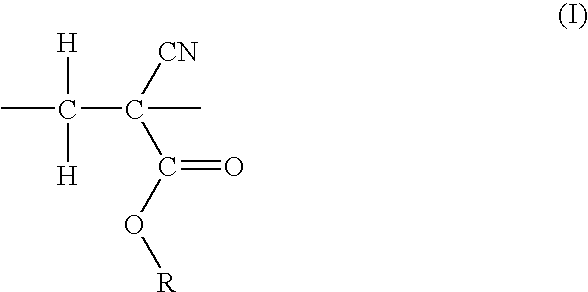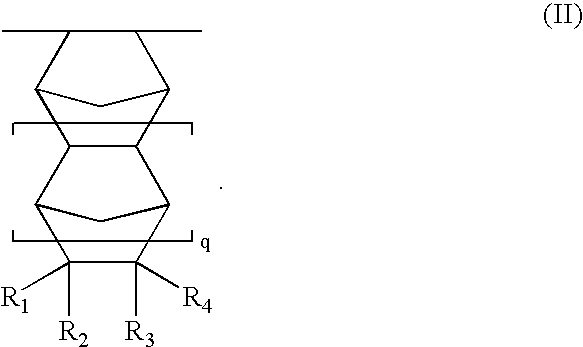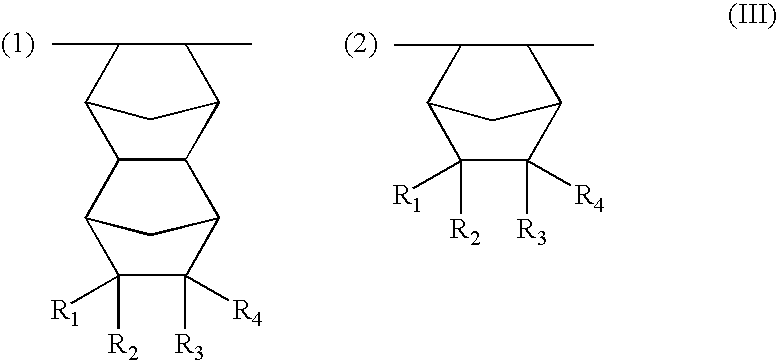Resist compositions with polymers having 2-cyano acrylic monomer
a technology of acrylic monomer and resist composition, which is applied in the field of resist compositions with polymers having 2cyano acrylic monomer, can solve the problems of limited ability to obtain finer resolution, inability to achieve the true resolution benefit of shorter wavelength imaging, and inability to produce smaller devices, etc., to achieve improved stability/shelf life, high resolution lithographic performance, and improved etch resistance
- Summary
- Abstract
- Description
- Claims
- Application Information
AI Technical Summary
Benefits of technology
Problems solved by technology
Method used
Image
Examples
example 1
Synthesis of copolymer of methylcyclopentyl 5-norbornene-2-carboxylate (NBMCP) and ethyl 2-cyanoacrylate (ECNA)
[0050]To a 100 ml glass vial (pre-dried to remove moisture) equipped with a magnetic stir bar was added 8.8 g (0.04 mole) of NBMCP, 0.135 g (0.0008 mole) of 2,2′-azobisisobutyronitrile (AIBN), 50 ml of anhydrous toluene, and the solution was degassed under argon atmosphere. 5.0 g (0.04 mole) of ECNA was added to the solution inside the dry box via a syringe. The resulting mixture was slowly heated to 75° C. and allowed to stir at 75° C. for an additional hour. The solution was cooled and precipitated into hexane to obtain a white polymer. The polymer was collected by vacuum filtration, washed with hexane (3×25 ml) and methanol (3×25 ml), and dried at 60° C. in vacuum overnight. Yield=5.4 g, 40%. GPC was obtained in THF using Polystyrene standards. The molecular weight was observed to be Mn=6,500 dalton and MW=12,200. 13C NMR indicated the presence of both NBMCP and ECNA mon...
example 2
Lithographic evaluation
[0051]For the purpose of lithographic experiments, a resist formulation containing the NBMCP-ECNA copolymer (Example 1) was prepared by combining the materials set forth below, expressed in part by weight.
[0052]
Cyclohexanone88.5NBMCP-ECNA copolymer (Example 1)11Di-t-butylphenyliodonium perfluorooctanesulfonate0.44perfluorobutylsulfonyloxybicyclo [2.2.1]-hept-5-ene-0.112,3-dicarboximideTetrabutylammonium hydroxide0.011
[0053]The resist formulation was spin-coated (for 30 seconds) onto an antireflective material (AR19, Shipley Company) layer applied on silicon wafers. The resist layer was soft-baked at 130° C. for 60 seconds on a vacuum hot plate to produce a film of about 0.36 μm thickness. The wafers were then exposed to 193 nm radiation (Nikon stepper, 0.6 NA). The exposure pattern was an array of lines and spaces of varying dimensions down to 0.1 μm. The exposed wafers were post-exposure baked on a vacuum hot plate at 130° C. for 90 seconds. The wafers were t...
PUM
| Property | Measurement | Unit |
|---|---|---|
| wavelength | aaaaa | aaaaa |
| size | aaaaa | aaaaa |
| size | aaaaa | aaaaa |
Abstract
Description
Claims
Application Information
 Login to View More
Login to View More - R&D
- Intellectual Property
- Life Sciences
- Materials
- Tech Scout
- Unparalleled Data Quality
- Higher Quality Content
- 60% Fewer Hallucinations
Browse by: Latest US Patents, China's latest patents, Technical Efficacy Thesaurus, Application Domain, Technology Topic, Popular Technical Reports.
© 2025 PatSnap. All rights reserved.Legal|Privacy policy|Modern Slavery Act Transparency Statement|Sitemap|About US| Contact US: help@patsnap.com



